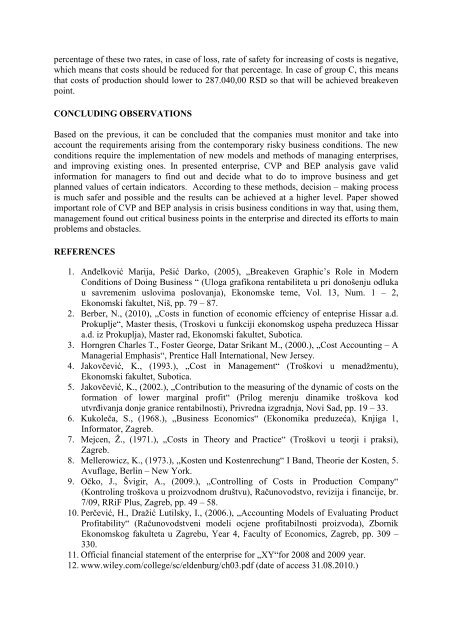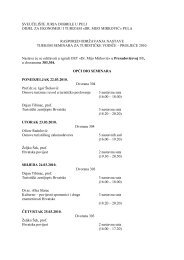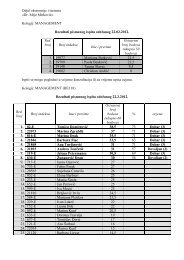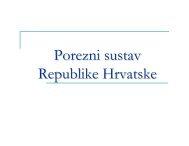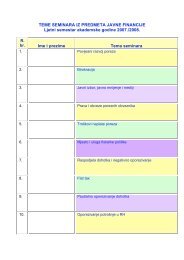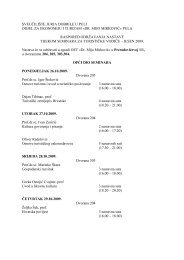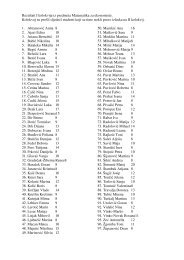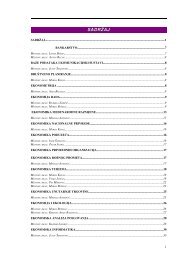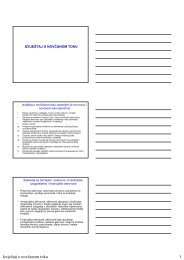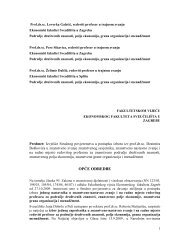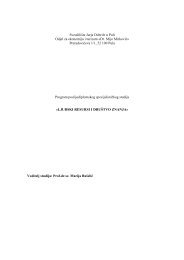BREAKEVEN GRAPHIC IN CRISIS BUSINESS CONDITIONS
the role of cost â volume â profit analysis and breakeven graphic in ...
the role of cost â volume â profit analysis and breakeven graphic in ...
You also want an ePaper? Increase the reach of your titles
YUMPU automatically turns print PDFs into web optimized ePapers that Google loves.
percentage of these two rates, in case of loss, rate of safety for increasing of costs is negative,<br />
which means that costs should be reduced for that percentage. In case of group C, this means<br />
that costs of production should lower to 287.040,00 RSD so that will be achieved breakeven<br />
point.<br />
CONCLUD<strong>IN</strong>G OBSERVATIONS<br />
Based on the previous, it can be concluded that the companies must monitor and take into<br />
account the requirements arising from the contemporary risky business conditions. The new<br />
conditions require the implementation of new models and methods of managing enterprises,<br />
and improving existing ones. In presented enterprise, CVP and BEP analysis gave valid<br />
information for managers to find out and decide what to do to improve business and get<br />
planned values of certain indicators. According to these methods, decision – making process<br />
is much safer and possible and the results can be achieved at a higher level. Paper showed<br />
important role of CVP and BEP analysis in crisis business conditions in way that, using them,<br />
management found out critical business points in the enterprise and directed its efforts to main<br />
problems and obstacles.<br />
REFERENCES<br />
1. Anđelković Marija, Pešić Darko, (2005), „Breakeven Graphic’s Role in Modern<br />
Conditions of Doing Business “ (Uloga grafikona rentabiliteta u pri donošenju odluka<br />
u savremenim uslovima poslovanja), Ekonomske teme, Vol. 13, Num. 1 – 2,<br />
Ekonomski fakultet, Niš, pp. 79 – 87.<br />
2. Berber, N., (2010), „Costs in function of economic effciency of enteprise Hissar a.d.<br />
Prokuplje“, Master thesis, (Troskovi u funkciji ekonomskog uspeha preduzeca Hissar<br />
a.d. iz Prokuplja), Master rad, Ekonomski fakultet, Subotica.<br />
3. Horngren Charles T., Foster George, Datar Srikant M., (2000.), „Cost Accounting – A<br />
Managerial Emphasis“, Prentice Hall International, New Jersey.<br />
4. Jakovčević, K., (1993.), „Cost in Management“ (Troškovi u menadžmentu),<br />
Ekonomski fakultet, Subotica.<br />
5. Jakovčević, K., (2002.), „Contribution to the measuring of the dynamic of costs on the<br />
formation of lower marginal profit“ (Prilog merenju dinamike troškova kod<br />
utvrđivanja donje granice rentabilnosti), Privredna izgradnja, Novi Sad, pp. 19 – 33.<br />
6. Kukoleča, S., (1968.), „Business Economics“ (Ekonomika preduzeća), Knjiga 1,<br />
Informator, Zagreb.<br />
7. Mejcen, Ž., (1971.), „Costs in Theory and Practice“ (Troškovi u teorji i praksi),<br />
Zagreb.<br />
8. Mellerowicz, K., (1973.), „Kosten und Kostenrechung“ I Band, Theorie der Kosten, 5.<br />
Avuflage, Berlin – New York.<br />
9. Očko, J., Švigir, A., (2009.), „Controlling of Costs in Production Company“<br />
(Kontroling troškova u proizvodnom društvu), Računovodstvo, revizija i financije, br.<br />
7/09, RRiF Plus, Zagreb, pp. 49 – 58.<br />
10. Perčević, H., Dražić Lutilsky, I., (2006.), „Accounting Models of Evaluating Product<br />
Profitability“ (Računovodstveni modeli ocjene profitabilnosti proizvoda), Zbornik<br />
Ekonomskog fakulteta u Zagrebu, Year 4, Faculty of Economics, Zagreb, pp. 309 –<br />
330.<br />
11. Official financial statement of the enterprise for „XY“for 2008 and 2009 year.<br />
12. www.wiley.com/college/sc/eldenburg/ch03.pdf (date of access 31.08.2010.)


